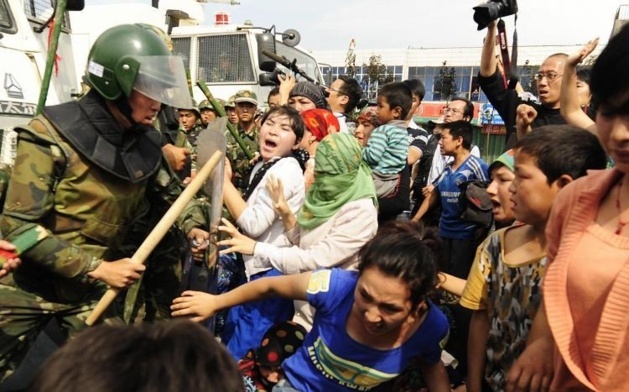
Crédit Photo -- Peter Parks/AFP/Getty Images
According to the BBC news from 28.06.13, the death toll in Xinjiang province, China has risen from 27 to 35. The assailants attacked a police station, a construction side and a local government building stabbing people and burning police cars on Wednesday, 26.06.13 in Turpan, Shanshan County. The Chinese state news agency Xinhua attributes the attacks to the banned East Turkistan Islamic Movement (ETIM), a ‘terrorist’ organisation.
Xinjiang – Terrorists or Nationalists?
The recent incident has been referred to by Xinhua as a terrorist attack against the Chinese provincial government in the autonomous province, yet there are serious doubts concerning the Chinese interpretation of terrorism. The Uyghur nationalist movements such as the World Uyghur Congress under Rebiya Kadeer have made use of terrorist allegations in accusing Beijing of being unable to differentiate between nationalism and separatism. ETIM, for example, which is supported by a minority of Uyghur is on the extreme end – yet, despite Chinese government allegations of connections to Taliban and Al Qaida, substantial proof of such connextions has been lacking. However, on the surface ETIM’s actions seem to fit the terrorist brief – most renown among them the bomb explosions in Kuqa, a city in the Northwest of Xinjiang on 10.08.2008 – during the Beijing Summer Olympics, which killed the ten assailants and one security guard. Yet, Beijing’s tendency to use terrorism as a political tool against separatism should be a matter of concern as it is ETIM’s objective to establish an independent Islamic state, called East Turkistan.
The Chinese government seems to have used the international climate of post-9/11 shock to set ETIM in 2002 on the ‘black list’ of terrorist groups in a wave of close collaboration with the United States within the United Nations on the War on Terror. More recently, on 21.05.13, China and Pakistan have agreed to view ETIM as a common threat agreeing to further cooperation on defence technology and production and continuance of the fight against the ‘three evil forces’ – extremism, terrorism and separatism. Especially the latter of the ‘three evil forces’ should be a matter of concern as the Chinese government indeed seems to fail to draw distinctions – between different nationalist and separatist groups on the one hand and on the other hand militant Uyghur activists, non-militant Uyghur activists and terrorists. In addition, Human Rights advocates in Xinjiang are concerned that these attacks will be used to justify further restrictions of Uyghur culture and religious freedom.
The Chinese government seems to have used the international climate of post-9/11 shock to set ETIM in 2002 on the ‘black list’ of terrorist groups in a wave of close collaboration with the United States within the United Nations on the War on Terror. More recently, on 21.05.13, China and Pakistan have agreed to view ETIM as a common threat agreeing to further cooperation on defence technology and production and continuance of the fight against the ‘three evil forces’ – extremism, terrorism and separatism. Especially the latter of the ‘three evil forces’ should be a matter of concern as the Chinese government indeed seems to fail to draw distinctions – between different nationalist and separatist groups on the one hand and on the other hand militant Uyghur activists, non-militant Uyghur activists and terrorists. In addition, Human Rights advocates in Xinjiang are concerned that these attacks will be used to justify further restrictions of Uyghur culture and religious freedom.
Human Rights and Ethnic Conflict
According to Human Rights Watch China, as part of the 2010 development plan, the local government has resorted to forced relocations and evictions of inhabitants in an attempt to break up traditional Uyghur neighbourhoods to ‘reduce socio-economic disparities’ and ‘smash separatist sentiment’. In addition, so Amnesty International, freedom of expression is extremely restricted, which is reflected in local legislation, which fails to clearly define crimes of ‘ethnic separatism’ and ‘terrorism’, which can be used to persecute authors of works or distributors of such containing ‘separatist material’. The Human Rights Watch China report further argues that Chinese government shortcomings – such as the extremely politicised judiciary, the omnipresent secret police and recent unexplained ‘disappearances’ in Xinjiang create a ‘climate of fear’ contributing to the growing ethnic polarisation. Indeed, what Beijing attributes to ‘terrorist activities’, could also be ascribed to ethnic conflict between the Uyghur and the Han Chinese, which is partially based on the persistence of social inequality between the ethnic groups and a city-countryside division. According to the 2000 census 75% of the population of Ürümqi were Han Chinese as opposed to 12% Uyghur, while in Kashgar Prefecture, at the border to Afghanistan and Pakistan, only 9% of the population were Han Chinese. Thence, despite the attempt of the central government to breach the rising gap with controversial resettlement policies, the Uyghur can keep questioning their ‘Chineseness’ referring to the historical independence of East Turkistan under strong Soviet assistance 1945-9 and the much disputed ‘peaceful return’ of Xinjiang to the newly unified communist China in 1949.



























